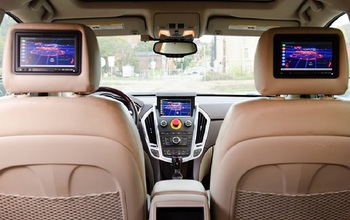News Release 17-005
NSF-funded self-driving car on display at Washington Auto Show public policy forum
NSF director to highlight critical role of basic research in transportation technology

NSF investments helped develop the technology that allows this car to operate autonomously.
January 19, 2017
This material is available primarily for archival purposes. Telephone numbers or other contact information may be out of date; please see current contact information at media contacts.
National Science Foundation (NSF) Director France Córdova will participate in MobilityTalks International, a public policy forum hosted by the Washington Auto Show on Jan. 24.
Córdova, accompanied by an NSF-funded self-driving Cadillac SRX, will highlight the essential role federal, basic research funding plays in current and future automobile-related innovations.
This first-ever MobilityTalks forum will allow world governments to exchange best practices related to emerging trends in transportation. Córdova will join an international group of automotive industry experts, lawmakers and regulators to deliver remarks and participate in a question and answer session focused on best practices related to connected and autonomous vehicles.
Media are invited to attend, and a limited number will be able to ride in the NSF-funded autonomous vehicle, which will be on display until 3:00 p.m. Jan. 24. The Washington Auto Show opens at the Walter E. Washington Convention Center on Jan. 27 and runs through Feb. 5.
EVENT DETAILS:
|
What: |
MobilityTalks International: Overview of the global mobility environment |
|
Who: |
France Córdova, NSF director Gary Peters, U.S. Senator (D-MI) Brian Kenner, deputy mayor for Planning & Economic Development, Washington, D.C Ryan Posten, associate administrator, National Highway Traffic Safety Administration Jean Shiomoto, administrator, California Department of Motor Vehicles John Bozzella, CEO, Global Automakers Yukihiro Ezaka, director for Engineering Policy, Japanese Road Transport Bureau Kim Kyung-hwan, vice minister for Land & Infrastructure, Korean Ministry of Land, Infrastructure & Transport Ian Yarnold, head of Standards, UK Department for Transport (Moderator) Mike Spector, The Wall Street Journal |
|
When: |
Tuesday, Jan. 24 at 8:30 a.m. |
|
Where: |
Walter E. Washington Convention Center, Salon ABC |
|
Media Registration |
To register for MobilityTalks International, please contact Joe Koch. |
|
Register to Ride Autonomous Vehicle |
Media interested in riding the autonomous vehicle the afternoon of Tuesday, Jan. 24, should contact Bobbie Mixon or Lisa-Joy Zgorski. |
MORE ABOUT THE SELF-DRIVING CAR:
NSF's Cyber-Physical Systems (CPS) program supported a team of researchers at Carnegie Mellon University that developed and integrated the parts to create the autonomous 2011 Cadillac SRX, which has six laser sensors, six radar units, three cameras and one thermal camera.
Specifically, CPS supported development of the following:
- Computer vision algorithms that allow the vehicle to drive safely by recognizing pedestrians, bicyclists, cars, buses, trucks and emergency vehicles.
- Traffic rule algorithms that allow the vehicle to follow traffic rules in different driving contexts to permit traveling in a safe fashion.
- Verification technologies that check for safety and correctness in the vehicle's life-critical systems, such as crash prevention.
- Vehicular communications systems that allow the car to "see" farther and more accurately by communicating with vehicles around it and other infrastructure, such as traffic lights and signs.
- Real-time, fault-tolerant computing that uses multiple layers of redundancy and has the ability to run several tasks at the same time within tight timing constraints.
The vehicle uses multiple roof-mounted antennas to receive high-accuracy GPS signals, while embedded displays in the backseat allow passengers to view what the vehicle is "seeing." A network of computers in the trunk run the car's complex software.
Researchers involved in the work, including Carnegie Mellon electrical and computer engineer Ragunathan "Raj" Rajkumar, will be on hand at the MobilityTalks forum to explain how the different sensors work.
-NSF-
Media Contacts
Bobbie Mixon, NSF, (703) 292-8070, email: bmixon@nsf.gov
Lisa-Joy Zgorski, NSF, (703) 292-8311, email: lisajoy@nsf.gov
Barbara Pomerance, The Washington Auto Show, 404-557-7200, email: bp@pomeranceassociates.com
Related Websites
Washington Auto Show: http://www.washingtonautoshow.com/
Raj Rajkumar of Carnegie Mellon University: https://users.ece.cmu.edu/~raj/
MobilityTalks International: http://www.washingtonautoshow.com/mobilitytalks/
The U.S. National Science Foundation propels the nation forward by advancing fundamental research in all fields of science and engineering. NSF supports research and people by providing facilities, instruments and funding to support their ingenuity and sustain the U.S. as a global leader in research and innovation. With a fiscal year 2023 budget of $9.5 billion, NSF funds reach all 50 states through grants to nearly 2,000 colleges, universities and institutions. Each year, NSF receives more than 40,000 competitive proposals and makes about 11,000 new awards. Those awards include support for cooperative research with industry, Arctic and Antarctic research and operations, and U.S. participation in international scientific efforts.
Connect with us online
NSF website: nsf.gov
NSF News: nsf.gov/news
For News Media: nsf.gov/news/newsroom
Statistics: nsf.gov/statistics/
Awards database: nsf.gov/awardsearch/
Follow us on social
Twitter: twitter.com/NSF
Facebook: facebook.com/US.NSF
Instagram: instagram.com/nsfgov


